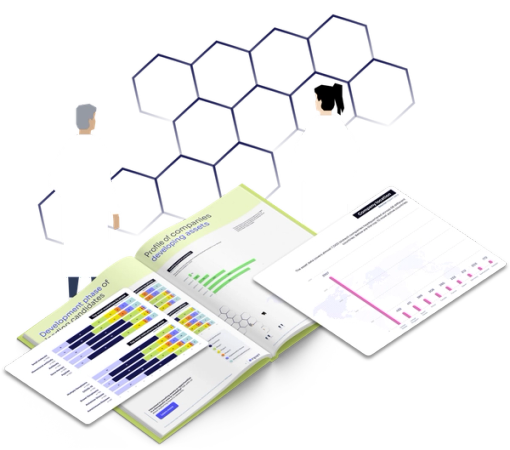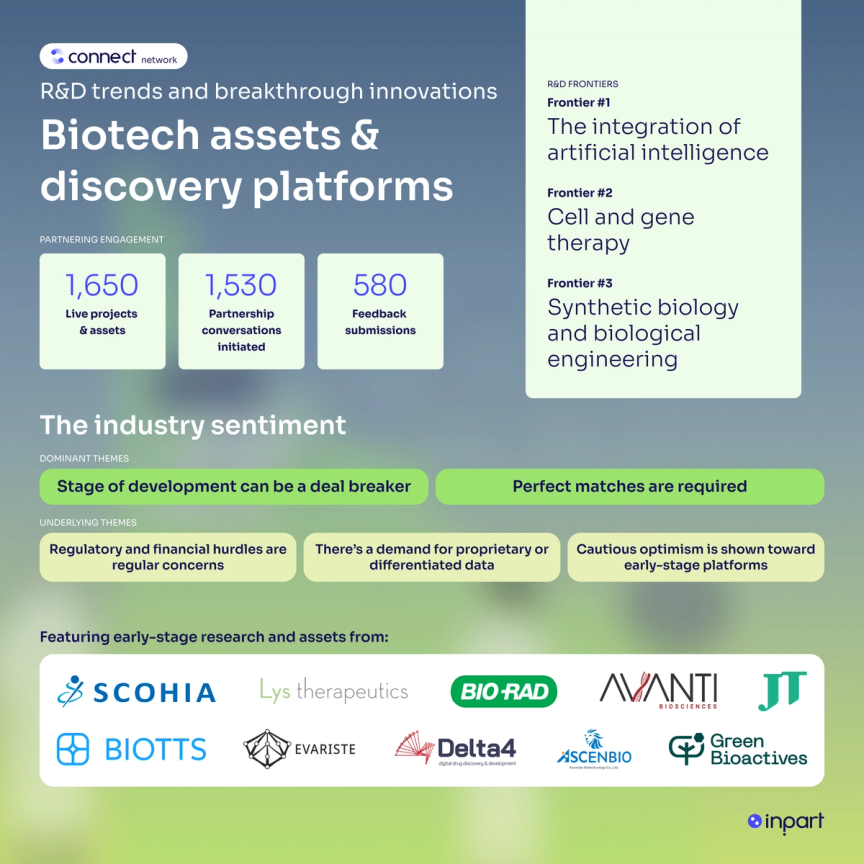Biotech assets & discovery platforms R&D trends and breakthrough innovations
This report identifies the latest trends in biotechnology R&D, surfacing the top assets and discovery platforms in development at biotech companies around the world.
The trends and breakthroughs in the report are identified by analyzing the engagement of industry teams using our online partnering platform to identify their next scientific partners. These insights should provide scientific decision-makers with a roadmap of high-impact opportunities in an evolving and competitive landscape, pinpointing emerging technologies and potential partners to advance biopharmaceutical R&D.

Download the report

Key R&D challenges for biotech
Biotechnology companies are pivotal in bridging the gap between academic research and the commercial application of science. Unlike research institutes which traditionally focus on exploration, biotechs emphasize faster, high-risk, high-reward development. However, bringing transformative biotechnology innovations to market requires external partnerships to fund, co-develop, and scale. This makes collaboration a critical element of the biotech ecosystem.
Partnering platforms such as Inpart help biotech companies connect with both research institutes and industry to drive innovation forward. By showcasing their assets to new prospective in-licensors, and submitting their work to calls from other companies, biotechs can access valuable partnerships. Taking this approach supports the commercialization of solutions to global healthcare challenges, while attracting the investment and licensing needed to bring scientific advances to market.
Frontier #1
Artificial intelligence
The integration of artificial intelligence (AI) across the biotech industry is occurring at a rapid pace, already revolutionizing processes such as drug discovery, predictive modelling, and personalized medicine. Machine learning models analyze vast datasets with high speed and precision, uncovering patterns missed by the human eye. The implementation of AI is reducing timelines, cutting costs, and enhancing accuracy. The impact of AI in biotech has been so great that it has been quoted that no future biotech can do without artificial intelligence.
Frontier #2
Cell and gene therapy
Cell and gene therapy is a frontier in biotech R&D at which rare and previously untreatable diseases are being addressed. These therapeutic approaches modify or replace genetic material within patients' cells to tackle root causes, offering long-lasting and personalized treatments for diseases including cancer, HIV, Parkinson's disease, and Type 1 diabetes. Cell and gene therapies saw a surge of investment during COVID-19, with the promise of what they can do still generating plenty of attention.
Frontier #3
Synthetic biology
By engineering biological systems with a synthetic biology approach, researchers can create organisms with new functions, enabling breakthroughs in producing biofuels, therapeutics, and biodegradable materials. Recent developments include realistic lab-grown meat and a new treatment for B-cell acute lymphoblastic leukemia by Novartis. However, challenges in scalability, ethical considerations, and regulation require extensive research to ensure safe, impactful deployment. Despite these complexities, the field holds promise for improving human health, protecting the environment, and creating a more sustainable future.
Biotech projects and assets
Review a sample of the six highest performing biotech projects and assets hosted on our online partnering platform.
To read the full summary article for each technology, asset or project, and to connect with the team developing them, you will need to join our online partnering platform.

1. A new small molecule for the treatment of idiopathic pulmonary fibrosis
Idiopathic pulmonary fibrosis is a severe lung disease marked by progressive scarring, inflammation, and tissue stiffening, eventually leading to respiratory failure. Current treatments, such as pirfenidone and nintedanib have side effects including gastrointestinal impacts and, in the case of pirfenidone, photosensitivity and skin rashes. There is a need for a therapy that addresses the underlying mechanisms of fibrosis and inflammation with minimal adverse effects.
Researchers at Avanti Biosciences have developed a new therapy targeting key enzymes driving idiopathic pulmonary fibrosis. Their asset reduces fibrosis, inflammation, and collagen buildup, offering a multi-targeted therapeutic approach. Itcan be administered via inhalation or orally, providing flexible options for the patient. With orphan drug status from the FDA and promising preclinical results, the team are seeking partners for co-development and licensing to improve treatment of idiopathic pulmonary fibrosis.
2. Innovative antibody therapies improving cancer immunotherapy
Cancer cells can evade the immune system by exploiting the TIGIT receptor on T-cells, suppressing their ability to fight tumors. Many cancers over express CD155, a protein that binds to TIGIT and dampens immune responses. Blocking this CD155/TIGIT interaction offers a promising approach to restoring immune function and improving treatment outcomes.
In California, Bio-Rad researchers have developed the Pioneer™ Antibody Discovery Platform and identified ten unique monoclonal antibodies with high sequence diversity, inhibiting the TIGIT/CD155 interaction. Preclinical trials have demonstrated positive results, such as stability and reactivity, and the team is seeking out-licensing opportunities for their technology.
3. Revolutionizing diabetes treatment by the transdermal delivery of insulin
It’s estimated that 10.4% of the global adult population has diabetes. The normal treatment involves multiple daily insulin injections. Although they are effective, they arealso invasive, inconvenient, and have side effects. More patient-friendly alternatives would be welcome to those living with diabetes.
At Biotts , researchers have developed a new carrier for insulin designed to replacedaily injections with a patch replacedonce or twice per week. The patch enables the transdermal delivery of insulin, ensuring sustained activity for up to five days. Results so far have shown high bioavailability (55%) and consistent plasma insulin levels. The team are seeking partners to co-develop and commercialize their product.
4. A new method to identify targets for synthetic lethality in oncology
Synthetic lethality, a type of interaction where the combination of two genetic events results in cell death, is an underexplored opportunity in oncology. The majority of research aroundsynthetic lethality is based around the same pathways, targets and biomarkers.
At Evariste , researchers have developed a method to identify untargeted synthetic lethal interactions, by integrating multi-modal dataand AI. Their innovation can accurately score novel targets and biomarkers, identifying novel synthetic lethal relationships with druggable targets. Their work has potential to advance oncology R&D, and the team are seeking a partner for commercialization, licensing and investment.
5. Designing therapeutic proteins using AI
Traditional methods of drug development, including phage displays and animal-based screenings, are often time-intensive and limited in scope. To effectively address complex diseases such as cancer and autoimmune disorders there is a need for a more efficient process of drug discovery.
At Ainnocence , researchers are developing an AI-powered protein design engine that enhances antibody affinity and addresses challenging targets, including membrane and secreted proteins.Their engine combines epitope mapping with de novo hit generation to screen up to 10^10 antibody sequences within days, reducing costs and timelines by up to 80%. The Ainnocence technology has applications across drug development, diagnostics, and enzyme optimization, and the team are seeking partners for co-development and commercialization.
6. An AI identifying new therapeutic leads
Drug discovery process is often slow and inefficient, with need for faster identification of indications and drug-disease connections. The use of AI is increasingly being explored by biopharma companies as a method to improve these approaches.
At Delta4 , a team of computational scientists have developed a new, AI-driven method to accelerate drug discovery byrevealing previously undetected relationships between drugs and disease areas. Their technologycan identify new indications for existing drugs, detecting new leads, and proposing prognostic biomarkers. Their approach is aiming to enable faster delivery of novel therapies to patients, and the team are seeking a partner for commercialization.
Listen to an audio digest of the editorial and report introduction
Join a global partnering network with 17,000 scientists and industry decision-makers
We connect academic institutes, researchers, companies and investors in a first-of-its-kind online network, unlocking the transformative power of science through partnering